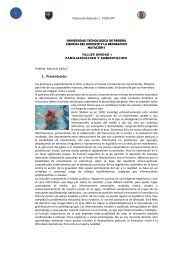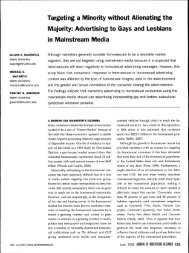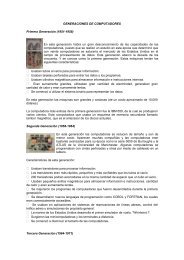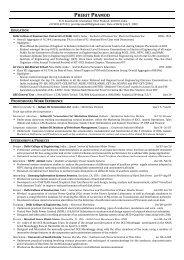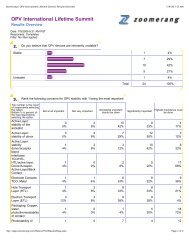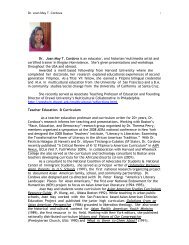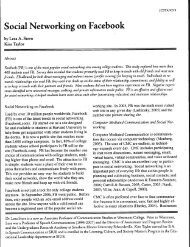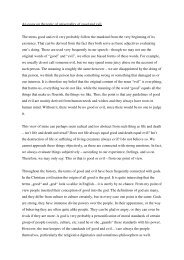A Comparison of Product Placements in Movies and Television ...
A Comparison of Product Placements in Movies and Television ...
A Comparison of Product Placements in Movies and Television ...
You also want an ePaper? Increase the reach of your titles
YUMPU automatically turns print PDFs into web optimized ePapers that Google loves.
CASE STUDIES<br />
OF PRODUCT PLACEMENT<br />
A <strong>Comparison</strong> <strong>of</strong> <strong>Product</strong> <strong>Placements</strong><br />
<strong>in</strong> <strong>Movies</strong> <strong>and</strong> <strong>Television</strong> Programs:<br />
An Onl<strong>in</strong>e Research Study<br />
Beng Soo Ong<br />
SUMMARY. <strong>Product</strong> placement has exp<strong>and</strong>ed as a promotional tactic,<br />
aided by technological <strong>in</strong>novations which present new open<strong>in</strong>gs for, <strong>and</strong><br />
challenges to, br<strong>and</strong>ed messages via television. <strong>Product</strong> placements <strong>in</strong><br />
television shows differ from placements <strong>in</strong> movies <strong>in</strong> terms <strong>of</strong> (1) federal<br />
regulations, (2) greater vehicle choices, <strong>and</strong> (3) ability to embed br<strong>and</strong>s<br />
<strong>in</strong>to TV shows that have proven to be successful. In light <strong>of</strong> these differ-<br />
Beng Soo Ong (PhD, University <strong>of</strong> Arkansas) is Pr<strong>of</strong>essor, Market<strong>in</strong>g <strong>and</strong> E-Bus<strong>in</strong>ess<br />
Department, Craig School <strong>of</strong> Bus<strong>in</strong>ess, Fresno State University, Peters Bus<strong>in</strong>ess<br />
Build<strong>in</strong>g, Room 508, M/S PB7, 5245 North Backer, Fresno, CA 93740-8001 (E-mail:<br />
bengo@csufresno.edu).<br />
[Haworth co-<strong>in</strong>dex<strong>in</strong>g entry note]: “A <strong>Comparison</strong> <strong>of</strong> <strong>Product</strong> <strong>Placements</strong> <strong>in</strong> <strong>Movies</strong> <strong>and</strong> <strong>Television</strong> Programs:<br />
An Onl<strong>in</strong>e Research Study.” Ong, Beng Soo. Co-published simultaneously <strong>in</strong> Journal <strong>of</strong> Promotion<br />
Management (Best Bus<strong>in</strong>ess Books, an impr<strong>in</strong>t <strong>of</strong> The Haworth Press, Inc.) Vol. 10, No. 1/2, 2004, pp. 147-158;<br />
<strong>and</strong>: H<strong>and</strong>book <strong>of</strong> <strong>Product</strong> Placement <strong>in</strong> the Mass Media: New Strategies <strong>in</strong> Market<strong>in</strong>g Theory, Practice,<br />
Trends, <strong>and</strong> Ethics (ed: Mary-Lou Galician) Best Bus<strong>in</strong>ess Books, an impr<strong>in</strong>t <strong>of</strong> The Haworth Press, Inc.,<br />
2004, pp. 147-158. S<strong>in</strong>gle or multiple copies <strong>of</strong> this article are available for a fee from The Haworth Document<br />
Delivery Service [1-800-HAWORTH, 9:00 a.m. - 5:00 p.m. (EST). E-mail address: docdelivery@haworthpress.<br />
com].<br />
http://www.haworthpress.com/web/JPM<br />
© 2004 by The Haworth Press, Inc. All rights reserved.<br />
Digital Object Identifier: 10.1300/J057v10n01_10 147
148 HANDBOOK OF PRODUCT PLACEMENT IN THE MASS MEDIA<br />
ences, an onl<strong>in</strong>e survey was conducted with the purpose <strong>of</strong> exam<strong>in</strong><strong>in</strong>g attitud<strong>in</strong>al<br />
differences, if any, between product placement <strong>in</strong> movies <strong>and</strong> <strong>in</strong><br />
TV programs. The study found that although three-fourths <strong>of</strong> the sample<br />
were aware <strong>of</strong> product placements <strong>in</strong> both media, respondents appeared<br />
to have less exposure to br<strong>and</strong> placements <strong>in</strong> television shows than <strong>in</strong><br />
movies. That may have led to a weak impact <strong>of</strong> television placements on<br />
respondents’ br<strong>and</strong> attitudes. [Article copies available for a fee from The<br />
Haworth Document Delivery Service: 1-800-HAWORTH. E-mail address:<br />
Website: <br />
© 2004 by The Haworth Press, Inc. All rights reserved.]<br />
KEYWORDS. Br<strong>and</strong>, films, movies, product placements, television<br />
INTRODUCTION<br />
While product placement is not a new market<strong>in</strong>g concept, the tactic<br />
has ga<strong>in</strong>ed <strong>in</strong> popularity as technological <strong>in</strong>novations <strong>in</strong> the past several<br />
years such as DVDs, <strong>in</strong>-home theater systems, <strong>and</strong> TiVo sets pose new<br />
opportunities for <strong>and</strong> threats to br<strong>and</strong> communications. TiVo will cont<strong>in</strong>ue<br />
to replace the video cassette player/recorder (VCR) as the consumers’<br />
tool for record<strong>in</strong>g missed television program segments, <strong>and</strong> for<br />
zapp<strong>in</strong>g television commercials. The growth <strong>in</strong> DVD rentals <strong>and</strong> sales<br />
at both brick-<strong>and</strong>-mortar stores <strong>and</strong> over the <strong>in</strong>ternet (e.g., via Amazon<br />
<strong>and</strong> Netflix), sales <strong>of</strong> digital TV sets, as well as the proliferation <strong>of</strong> payper-view<br />
channels also present open<strong>in</strong>gs for br<strong>and</strong> communications<br />
through television.<br />
Recogniz<strong>in</strong>g the fact that consumers are <strong>in</strong>undated with a vast number<br />
<strong>of</strong> TV channel choices (<strong>and</strong> subsequently turn<strong>in</strong>g some <strong>of</strong> us <strong>in</strong>to channel<br />
surfers), hav<strong>in</strong>g a br<strong>and</strong> featured or embedded <strong>in</strong>to a popular TV<br />
program would likely ga<strong>in</strong> more attention or exposure than hav<strong>in</strong>g the<br />
br<strong>and</strong> advertised between program breaks.<br />
PURPOSE OF STUDY<br />
While films cont<strong>in</strong>ue to draw audiences to theaters/c<strong>in</strong>emas, the secondary<br />
outlets <strong>of</strong> these films through television runs, re-runs, video <strong>and</strong><br />
DVD rentals/sales cannot be overlooked. In light <strong>of</strong> the trends alluded<br />
to earlier, it would be timely to <strong>in</strong>vestigate the impact <strong>of</strong> product place-
ments <strong>in</strong> movies where the movies were subsequently shown on TV.<br />
Furthermore, comparisons <strong>of</strong> consumer perceptions <strong>of</strong> product placement<br />
practices <strong>in</strong> films versus TV programs could shed additional<br />
knowledge <strong>of</strong> different impacts, if any, <strong>of</strong> this important br<strong>and</strong> promotion<br />
tool. Hence, this study seeks to ascerta<strong>in</strong> awareness <strong>of</strong>, <strong>and</strong> attitud<strong>in</strong>al<br />
differences between, product placement <strong>in</strong> movies <strong>and</strong> <strong>in</strong> television.<br />
BACKGROUND<br />
Regulations <strong>of</strong> <strong>Product</strong> <strong>Placements</strong> <strong>in</strong> TV Programs<br />
Avery <strong>and</strong> Ferraro (2000) expla<strong>in</strong>ed that placements <strong>in</strong> television<br />
programs are usually unpaid because the Federal Communications<br />
Commission (FCC) has sponsorship identification rules govern<strong>in</strong>g paid<br />
placements <strong>in</strong> this medium. <strong>Placements</strong> <strong>in</strong> movies, on the other h<strong>and</strong>,<br />
are unregulated. The above FCC rule, however, does not apply to movies<br />
air<strong>in</strong>g on television. To work around this “payment” restriction for<br />
television program placements, companies could (<strong>and</strong> <strong>of</strong>ten do) simply<br />
supply products free <strong>of</strong> charge to the syndicates or producers <strong>of</strong> the particular<br />
television program <strong>of</strong> <strong>in</strong>terest. Staff <strong>and</strong> actors on the production<br />
set could be given the free product to consume, use, wear, or <strong>in</strong> turn,<br />
give away to others.<br />
<strong>Product</strong>s that are furnished as backdrops for a TV program scene do<br />
not have to be disclosed as long as they are not portrayed <strong>in</strong> an unreasonable<br />
manner that implies “commercial <strong>in</strong>tent.” Hence, we could argue<br />
that placements <strong>in</strong> TV programs are likely to be more subtle than<br />
placements <strong>in</strong> movies to avoid violations <strong>of</strong> the FCC rule. This subtlety<br />
could work <strong>in</strong> the favor <strong>of</strong> placements on TV as unrestricted placements<br />
<strong>in</strong> movies may tend toward overly obvious plugs for the br<strong>and</strong>. In their<br />
qualitative research, DeLorme <strong>and</strong> Reid (1999) found that their subjects<br />
were very aware <strong>of</strong> excessive show<strong>in</strong>g <strong>of</strong> the br<strong>and</strong> <strong>and</strong> placements <strong>in</strong><br />
unnatural or <strong>in</strong>appropriate sett<strong>in</strong>gs <strong>in</strong>clud<strong>in</strong>g over-emphasis through<br />
camera techniques (e.g., close-ups on the br<strong>and</strong> name). Their subjects<br />
noted that such actions cheapen the movie-go<strong>in</strong>g experience <strong>and</strong> <strong>in</strong>sult<br />
the audience.<br />
<strong>Placements</strong> <strong>in</strong> Successful TV Series<br />
Case Studies <strong>of</strong> <strong>Product</strong> Placement 149<br />
Br<strong>and</strong> placement <strong>in</strong> a television series may have an advantage over<br />
that <strong>in</strong> a movie as placements may be made after ample opportunities to
150 HANDBOOK OF PRODUCT PLACEMENT IN THE MASS MEDIA<br />
gauge the size <strong>of</strong> the viewership. With movies, the placement decision<br />
would have to be made on the basis <strong>of</strong> forecast(s) <strong>of</strong> the success <strong>of</strong> the<br />
movie. Even if the movie were subsequently aired on television, br<strong>and</strong><br />
placements are unlikely to be developed <strong>and</strong> <strong>in</strong>serted <strong>in</strong>to the movie at<br />
that po<strong>in</strong>t due to costs <strong>and</strong> time.<br />
Many studies have noted that the impact <strong>of</strong> a placement is <strong>in</strong>fluenced<br />
by the position or scene <strong>in</strong> the program or movie (e.g., DeLorme <strong>and</strong><br />
Reid, 1999; Russell, 2002; Ong <strong>and</strong> Meri, 1994). A television series may<br />
earn a loyal audience follow<strong>in</strong>g where there would be more opportunity<br />
to build personalities <strong>of</strong> the characters <strong>in</strong> the series, <strong>and</strong> to design a<br />
script or scene to fit the br<strong>and</strong> placement <strong>in</strong> a very appropriate sett<strong>in</strong>g.<br />
Choices <strong>of</strong> TV Program Formats for <strong>Placements</strong><br />
TV programs can be classified <strong>in</strong>to situation comedy, documentary,<br />
drama series, feature magaz<strong>in</strong>e (e.g., NBC’s Datel<strong>in</strong>e; ABC’s 20/20,<br />
etc.), game-show, sports, made-for-TV movie, news program, <strong>and</strong> other<br />
types (Avery <strong>and</strong> Ferraro, 2000). Because <strong>of</strong> the wide choice <strong>of</strong> formats,<br />
br<strong>and</strong> placements <strong>in</strong> a TV program enjoy greater flexibilities than those<br />
<strong>in</strong> a movie. Due to restrictions on violence, nudity, <strong>and</strong> language (pr<strong>of</strong>anity)<br />
<strong>in</strong> program content <strong>of</strong>fered by major US networks (i.e., ABC,<br />
NBC, CBS, <strong>and</strong> FOX), f<strong>in</strong>d<strong>in</strong>g appropriate br<strong>and</strong> placements may also<br />
be less challeng<strong>in</strong>g here than <strong>in</strong> movies. From the author/researcher’s<br />
experience, scour<strong>in</strong>g for potential br<strong>and</strong> starr<strong>in</strong>g roles to recommend to<br />
an advertis<strong>in</strong>g agency h<strong>and</strong>l<strong>in</strong>g a major studio’s account, the prospect<br />
was greatly curtailed by the presence <strong>of</strong> violence <strong>and</strong> by the place/sett<strong>in</strong>g<br />
(e.g., mid-1800s, <strong>in</strong> the City <strong>of</strong> Birm<strong>in</strong>gham) evident <strong>in</strong> the movie<br />
script. The br<strong>and</strong> <strong>in</strong> m<strong>in</strong>d (to be potentially placed) may not have existed<br />
at that time, or may no longer be around today. TV programs, particularly<br />
situational comedies, tend to have more contemporary sett<strong>in</strong>gs.<br />
Hence, the availability <strong>of</strong> greater choices <strong>and</strong> flexibilities <strong>in</strong> TV program<br />
placements may lead to more natural or appropriate placements.<br />
However, the contemporary sett<strong>in</strong>gs <strong>of</strong> many TV series could also <strong>in</strong>crease<br />
the pressure on show producers to feature real br<strong>and</strong>s <strong>in</strong> program<br />
scenes even if these would not be “pay<strong>in</strong>g” br<strong>and</strong>s. DeLorme <strong>and</strong> Reid<br />
(1999) found that consumers felt irritated <strong>and</strong> <strong>in</strong>sulted by generic product<br />
props. These props were judged to <strong>in</strong>terfere with movie realism <strong>and</strong><br />
to <strong>in</strong>terrupt the movie view<strong>in</strong>g experience. Hence, the use <strong>of</strong> generic<br />
props <strong>and</strong> fictitious br<strong>and</strong>s would not be ideal if there were no suitors<br />
for the br<strong>and</strong> role.
Case Studies <strong>of</strong> <strong>Product</strong> Placement 151<br />
Measur<strong>in</strong>g Effectiveness <strong>of</strong> <strong>Product</strong> <strong>Placements</strong><br />
Research <strong>in</strong> the early 1990s tended to measure effectiveness <strong>of</strong> product<br />
placements by aided <strong>and</strong> unaided recalls <strong>of</strong> br<strong>and</strong>s mentioned or<br />
shown <strong>in</strong> the movie (Gupta <strong>and</strong> Lord, 1998). S<strong>in</strong>ce then, more researchers<br />
have opted for attitud<strong>in</strong>al measures <strong>and</strong> purchase <strong>in</strong>tentions. For example,<br />
Gould, Gupta, <strong>and</strong> Grabner-Krauter (2000) compared consumer<br />
attitudes across their three-country samples on dimensions such as attitude<br />
toward product placement <strong>in</strong> general, perceived realism (e.g.,<br />
Strongly Agree to Strongly Disagree for a statement “Placement <strong>of</strong> br<strong>and</strong><br />
name products adds to the realism <strong>of</strong> movies”), attitude toward restrict<strong>in</strong>g<br />
product placements, <strong>and</strong> attitude toward television advertis<strong>in</strong>g <strong>in</strong><br />
general. Purchase behavior, <strong>in</strong> their study, was assessed via a Likertscale<br />
item “I buy br<strong>and</strong>s I see movie stars us<strong>in</strong>g or hold<strong>in</strong>g <strong>in</strong> movies.”<br />
One might argue that the above attitud<strong>in</strong>al items would not be good<br />
correlates <strong>of</strong> purchase <strong>in</strong>tentions <strong>and</strong> br<strong>and</strong> choice s<strong>in</strong>ce product placements<br />
are subtle <strong>and</strong> consumers’ br<strong>and</strong> decisions are <strong>in</strong>fluenced by a host<br />
<strong>of</strong> other market<strong>in</strong>g factors such as a br<strong>and</strong>’s unique sell<strong>in</strong>g proposition<br />
(USP) <strong>and</strong> specific qualities. However, DeLorme <strong>and</strong> Reid (1999)<br />
noted that moviegoers are active <strong>in</strong>terpreters, not passive receptors <strong>of</strong><br />
encountered br<strong>and</strong>s <strong>in</strong> movies. Subtle cues via placements are not likely<br />
to go unnoticed by the audience. The researchers further argued that because<br />
attitudes toward br<strong>and</strong>s develop over time, br<strong>and</strong> placement can<br />
strengthen br<strong>and</strong> name recognition <strong>and</strong> position<strong>in</strong>g, <strong>and</strong> thus contribute<br />
towards long-term <strong>in</strong>fluence. Br<strong>and</strong> placement can create associations<br />
that are important <strong>in</strong> build<strong>in</strong>g a br<strong>and</strong>’s image, which <strong>in</strong> turn, could be a<br />
part <strong>of</strong> the gr<strong>and</strong> market<strong>in</strong>g plan.<br />
Psychographic <strong>and</strong> demographic factors may significantly impact the<br />
effectiveness <strong>of</strong> product placements <strong>and</strong>, hence, their <strong>in</strong>clusion <strong>in</strong> product<br />
placement research would be prudent. In a study <strong>of</strong> moviegoers’ experiences<br />
<strong>and</strong> <strong>in</strong>terpretations <strong>of</strong> br<strong>and</strong>s <strong>in</strong> films, DeLorme <strong>and</strong> Reid (1999)<br />
found older moviegoers to be receptive to “old br<strong>and</strong>s” <strong>in</strong> the movie <strong>and</strong><br />
related nostalgia associations. To the younger moviegoers <strong>in</strong> the study,<br />
br<strong>and</strong>s <strong>in</strong> movies symbolized belong<strong>in</strong>g <strong>and</strong> security.<br />
Gould, Gupta, <strong>and</strong> Grabner-Krauter (2000) employed psychographic<br />
measures such as the total number <strong>of</strong> movies rented or watched <strong>in</strong> theaters<br />
<strong>in</strong> a typical month when study<strong>in</strong>g product placement effects. However,<br />
they did not f<strong>in</strong>d the total number <strong>of</strong> movies rented/watched to be<br />
significant on purchase behavior. In the context <strong>of</strong> product placements<br />
<strong>in</strong> TV programs, it may be worthwhile to explore attributes such as whether<br />
research participants typically watch television alone or with another
152 HANDBOOK OF PRODUCT PLACEMENT IN THE MASS MEDIA<br />
person, subscribe to cable, or when they typically watch television. In a<br />
multi-audience sett<strong>in</strong>g, there are likely to be more <strong>in</strong>teractions among<br />
the audience members while watch<strong>in</strong>g television than while view<strong>in</strong>g a<br />
movie <strong>in</strong> a theater. Greater <strong>in</strong>teraction among the people <strong>in</strong> the room<br />
may also lead to different reactions to a br<strong>and</strong> placement than when<br />
watch<strong>in</strong>g a program alone.<br />
While academicians <strong>and</strong> scholars are striv<strong>in</strong>g for stronger measures<br />
<strong>of</strong> effectiveness <strong>of</strong> product placement, advertisers <strong>and</strong> practitioners are<br />
seek<strong>in</strong>g to justify their expenditures <strong>in</strong> product placement. A new company,<br />
Br<strong>and</strong> Advisors, has come up with a pric<strong>in</strong>g model that takes <strong>in</strong>to<br />
account the size <strong>of</strong> the audience the movie may attract throughout its<br />
life cycle (at the box <strong>of</strong>fice, home video, pay-per-view, <strong>and</strong> television),<br />
<strong>and</strong> the starr<strong>in</strong>g role the br<strong>and</strong> is <strong>of</strong>fered <strong>in</strong> the movie (Graser, 2003).<br />
Br<strong>and</strong> Advisors’ f<strong>in</strong>ancial assessment <strong>of</strong> product placement project<br />
states the audience size projections can be reforecast <strong>and</strong> repriced once<br />
the movie hits the theaters or airs on TV, allow<strong>in</strong>g partners to alter their<br />
arrangement based on actual results as the movie moves <strong>in</strong>to other distribution<br />
w<strong>in</strong>dows.<br />
In regards to br<strong>and</strong> starr<strong>in</strong>g role, a car placement would be <strong>of</strong> greater<br />
market<strong>in</strong>g value if it is driven by the lead characters <strong>and</strong> the automaker’s<br />
tie-<strong>in</strong> sponsorship is <strong>in</strong>cluded <strong>in</strong> the movie’s DVD release than a placement<br />
where the car appeared briefly <strong>in</strong> the movie. However, Ong <strong>and</strong><br />
Meri (1994) questioned whether tie-<strong>in</strong> sponsorship underm<strong>in</strong>es the positive<br />
impact <strong>of</strong> product placement. They argued the audience may be<br />
sensitized to the po<strong>in</strong>t <strong>of</strong> view<strong>in</strong>g the br<strong>and</strong> placement as tacky, too deliberate,<br />
or “not natural.” Their contention <strong>of</strong> tie-<strong>in</strong> sponsorships impact<strong>in</strong>g<br />
product placement values unfortunately has yet to be explored<br />
<strong>in</strong> a research study.<br />
METHODOLOGY<br />
An onl<strong>in</strong>e survey to assess consumers’ attitudes toward product placement<br />
<strong>in</strong> movies <strong>and</strong> <strong>in</strong> TV programs was developed at a pr<strong>of</strong>essional<br />
survey builder website (i.e., Formsite.com). The survey was also hosted<br />
there. Follow<strong>in</strong>g an <strong>in</strong>troduction <strong>of</strong> the researchers conduct<strong>in</strong>g the survey,<br />
<strong>and</strong> an explanation <strong>of</strong> the purpose <strong>of</strong> the survey, respondents were<br />
provided with a brief description <strong>of</strong> product/br<strong>and</strong> placements <strong>in</strong> a<br />
movie or TV show. Respondents were told that the camera would focus<br />
on the br<strong>and</strong> or logo for a few seconds if the placement was <strong>in</strong>tentional.<br />
They would also likely see the characters <strong>in</strong> the movie/program us<strong>in</strong>g or
Case Studies <strong>of</strong> <strong>Product</strong> Placement 153<br />
hold<strong>in</strong>g the product with the real br<strong>and</strong>/packag<strong>in</strong>g featured rather than a<br />
fictitious br<strong>and</strong> or generic label such as “pizza” on the package. The br<strong>and</strong><br />
may also be <strong>in</strong>tentionally featured <strong>in</strong> the background <strong>of</strong> a scene.<br />
Early <strong>in</strong> the onl<strong>in</strong>e questionnaire, respondents were asked to list the<br />
name <strong>of</strong> the show/movie/program or series <strong>in</strong> which they have seen/heard a<br />
product/br<strong>and</strong> placement embedded with<strong>in</strong> that show/program. Two<br />
open-ended questions were employed to probe the specific product/<br />
br<strong>and</strong> seen/heard, <strong>and</strong> nature/scene <strong>of</strong> the placement (i.e., was the placement<br />
subtle or an “<strong>in</strong>-your-face” type; was the placement verbal or visual<br />
or both).<br />
When answer<strong>in</strong>g the above questions, respondents were asked to<br />
th<strong>in</strong>k <strong>of</strong> TV shows or episodes <strong>in</strong> which they have watched the entire<br />
program/show on any <strong>of</strong> the major networks (i.e., ABC, NBC, CBS,<br />
<strong>and</strong> FOX) dur<strong>in</strong>g the prime time hours <strong>of</strong> 7 p.m. to 11 p.m. dur<strong>in</strong>g a particular<br />
week. The data collection was conf<strong>in</strong>ed to a seven-day period,<br />
but the researchers also tape recorded one week earlier as well <strong>in</strong> case<br />
respondents referred to a placement <strong>in</strong> a prior program. So television<br />
programs on all four major networks dur<strong>in</strong>g the hours <strong>of</strong> 7 p.m. to 11 p.m.<br />
were recorded for a 14-day block, with the first record<strong>in</strong>g day be<strong>in</strong>g one<br />
week before the start<strong>in</strong>g date <strong>of</strong> the data collection. The recorded programs<br />
provided the researchers a way to validate the product placements<br />
respondents said they recalled see<strong>in</strong>g/hear<strong>in</strong>g on TV. The<br />
validation will be conducted <strong>and</strong> reported <strong>in</strong> a future article.<br />
Respondents were solicited via e-mail survey <strong>in</strong>vitations. Several<br />
students <strong>in</strong> an undergraduate market<strong>in</strong>g class were <strong>in</strong>volved <strong>in</strong> the data<br />
collection. They e-mailed the survey <strong>in</strong>vitations (conta<strong>in</strong><strong>in</strong>g a hyperl<strong>in</strong>k<br />
to the survey hosted at formsite.com) to their friends, relatives, family<br />
members, <strong>and</strong> colleagues at work.<br />
A total <strong>of</strong> 117 people responded to the survey but only 99 <strong>of</strong> these respondents<br />
fully completed the rather lengthy onl<strong>in</strong>e questionnaire. Of the<br />
91 respondents who <strong>in</strong>dicated their gender, approximately 58% were females,<br />
<strong>and</strong> 42% were males. Approximately 65% <strong>of</strong> the respondents<br />
were between the ages <strong>of</strong> “18 to 35.” Another 15% were <strong>in</strong> the “36 to 49”<br />
age bracket while the rema<strong>in</strong><strong>in</strong>g 20% were <strong>in</strong> the “50+” age group.<br />
FINDINGS AND DISCUSSION<br />
On the first question, “Were you aware <strong>of</strong> product placement before<br />
read<strong>in</strong>g the <strong>in</strong>troduction to this survey?” almost three-fourths <strong>of</strong> the 117<br />
respondents <strong>in</strong>dicated that they were aware <strong>of</strong> product/br<strong>and</strong> placement
154 HANDBOOK OF PRODUCT PLACEMENT IN THE MASS MEDIA<br />
<strong>in</strong> both movies <strong>and</strong> TV programs. Approximately 12% were not aware<br />
<strong>of</strong> this promotional practice <strong>in</strong> movies or <strong>in</strong> TV programs. Compar<strong>in</strong>g<br />
the awareness <strong>of</strong> product placements <strong>in</strong> movies <strong>and</strong> TV programs, 10%<br />
reported be<strong>in</strong>g aware <strong>of</strong> placements <strong>in</strong> movies only. Even fewer (i.e.,<br />
3%) <strong>in</strong>dicated such awareness for TV programs only. From a public<br />
policy st<strong>and</strong>po<strong>in</strong>t, it is evident that product placement is not a stealth<br />
market<strong>in</strong>g tactic that works at consumers’ subconscious levels as some<br />
critics <strong>of</strong> product placement may claim. The practice <strong>of</strong> embedd<strong>in</strong>g<br />
br<strong>and</strong>s with<strong>in</strong> a program/movie (even <strong>in</strong> television programs) is widely<br />
known by the public.<br />
On the next question, 77% <strong>of</strong> the 117 respondents <strong>in</strong>dicated that they<br />
had watched at least one whole TV episode or show on a major network<br />
dur<strong>in</strong>g prime time that week. Among the 53 people that <strong>in</strong>dicated which<br />
shows they did watch or products they recalled (or didn’t recall) see<strong>in</strong>g,<br />
seven people noted a specific br<strong>and</strong> appearance/scene <strong>in</strong> a specific TV<br />
show, <strong>and</strong> six respondents named a few br<strong>and</strong>s they recalled see<strong>in</strong>g <strong>in</strong><br />
movies aired on TV. While these responses have yet to be validated via<br />
the recorded programs, it appears that television placement br<strong>and</strong> recall<br />
ability was not as good as those reported for movie placements <strong>in</strong> other<br />
studies (e.g., DeLorme <strong>and</strong> Reid, 1999; Ong <strong>and</strong> Meri, 1994). Perhaps,<br />
there are not as many placements <strong>in</strong> TV programs as <strong>in</strong> movies. It may<br />
be more difficult for respondents to recall a placement from a number <strong>of</strong><br />
TV programs they have watched dur<strong>in</strong>g the week than to recall br<strong>and</strong>s<br />
seen <strong>in</strong> a specific movie. Interest<strong>in</strong>gly, 64% <strong>of</strong> the respondents who do<br />
rent/purchase movies to watch at home <strong>in</strong>dicated that they do recall see<strong>in</strong>g<br />
product placements <strong>in</strong> the movies.<br />
To ascerta<strong>in</strong> attitud<strong>in</strong>al differences, if any, between product placements<br />
<strong>in</strong> TV programs <strong>and</strong> <strong>in</strong> movies, paired t-tests were performed on<br />
the follow<strong>in</strong>g items (see Table 1) as the mean rat<strong>in</strong>gs comparisons were<br />
with<strong>in</strong>-subjects. As can be seen from Table 1, none <strong>of</strong> the five-paired<br />
item comparisons yielded f<strong>in</strong>d<strong>in</strong>gs <strong>of</strong> significant differences. It is important<br />
to po<strong>in</strong>t out here that similar questionnaire items perta<strong>in</strong><strong>in</strong>g to<br />
TV product placement <strong>and</strong> to movie placement were spaced far apart <strong>in</strong><br />
the onl<strong>in</strong>e questionnaire so as to m<strong>in</strong>imize sensitiz<strong>in</strong>g subjects to the <strong>in</strong>tents<br />
<strong>of</strong> the similar questions. For some <strong>of</strong> these paired items, the questions<br />
appeared on different screens (pages). It appears that subjects <strong>in</strong><br />
this study do not perceive product placements differently depend<strong>in</strong>g on<br />
the medium <strong>of</strong> delivery (i.e., movies versus TV programs).<br />
As to why only an N = 77 to 78 is reported <strong>in</strong> this table, the numerous<br />
Likert items were grouped <strong>in</strong> blocks <strong>of</strong> 4 or 5 items arranged <strong>in</strong> a grid<br />
format onl<strong>in</strong>e. These grid questions usually appear to be “labor <strong>in</strong>ten-
Case Studies <strong>of</strong> <strong>Product</strong> Placement 155<br />
TABLE 1. Attitudes Toward <strong>Product</strong> Placement <strong>in</strong> <strong>Movies</strong> <strong>and</strong> <strong>in</strong> TV Programs<br />
Attitud<strong>in</strong>al Items Mean<br />
From the product placements I have been exposed to on TV, br<strong>and</strong>s were<br />
cast <strong>in</strong> a positive image.<br />
From the product placements I have been exposed to <strong>in</strong> the movies,<br />
br<strong>and</strong>s were cast <strong>in</strong> a positive image.<br />
<strong>Product</strong> placement is an unethical form <strong>of</strong> advertis<strong>in</strong>g <strong>in</strong> TV<br />
programs/shows.<br />
<strong>Product</strong> placement <strong>in</strong> movies is an unethical form <strong>of</strong> advertis<strong>in</strong>g.<br />
<strong>Product</strong> placement enhances the reality <strong>of</strong> a scene <strong>in</strong> a TV program/show.<br />
<strong>Product</strong> placement enhances the reality <strong>of</strong> a movie.<br />
Br<strong>and</strong>s that appear <strong>in</strong> TV product placement are usually the well-known<br />
br<strong>and</strong>s.<br />
Br<strong>and</strong>s that appear <strong>in</strong> movie product placement are usually the well-known<br />
br<strong>and</strong>s.<br />
If there were product placements <strong>in</strong> a show, I would be aware <strong>of</strong> them.<br />
If there were product placements <strong>in</strong> a movie, I would be quick to notice<br />
them.<br />
Note: 1 = Strongly Agree; 5 = Strongly Disagree. N ranges from 77 to 78.<br />
None <strong>of</strong> the paired t-test results were significant at the 0.05 level.<br />
sive” for respondents. Hence, my decision not to make the items required<br />
questions. That way, respondents can skip to the later questions<br />
that they wish to answer. From my experience, mak<strong>in</strong>g grid questions<br />
compulsory tends to result <strong>in</strong> “less committed” respondents click<strong>in</strong>g the<br />
X on their browser <strong>and</strong> dropp<strong>in</strong>g out <strong>of</strong> the survey completely.<br />
Unlike the qualitative results observed <strong>in</strong> the DeLorme <strong>and</strong> Reid (1999)<br />
study, the survey results here seemed to suggest that the impact <strong>of</strong> product<br />
placements was weak. Respondents tend to disagree that they can<br />
usually remember the product/br<strong>and</strong> placement(s) a few weeks after they<br />
have seen the placements (mean rat<strong>in</strong>g = 3.71 where 1 = Strongly Agree<br />
<strong>and</strong> 5 = Strongly Disagree). Similarly, subjects disagreed that they do<br />
usually remember the br<strong>and</strong> or company that sponsored a particular TV<br />
program or show after a few weeks (mean = 3.59). Aga<strong>in</strong>, respondents<br />
tend to disagree that when they see a particular br<strong>and</strong> at a store or supermarket<br />
that had appeared <strong>in</strong> a TV show or movie, they would usually<br />
th<strong>in</strong>k <strong>of</strong> that placement scene <strong>in</strong> the show/movie (mean = 3.44). These<br />
f<strong>in</strong>d<strong>in</strong>gs were somewhat surpris<strong>in</strong>g as subjects <strong>in</strong> the study agreed that<br />
2.15<br />
2.14<br />
3.68<br />
3.65<br />
2.62<br />
2.62<br />
2.12<br />
2.05<br />
2.58<br />
2.64
156 HANDBOOK OF PRODUCT PLACEMENT IN THE MASS MEDIA<br />
they are usually focused on the story/content when watch<strong>in</strong>g TV (mean =<br />
1.58 where 1 = Strongly Agree <strong>and</strong> 5 = Strongly Disagree), <strong>and</strong> disagreed<br />
that they usually engage <strong>in</strong> TV channel surf<strong>in</strong>g <strong>and</strong> hardly watch<br />
full episodes <strong>of</strong> any program (mean = 3.53).<br />
Consumers <strong>in</strong> the study tend to agree that product placements do not<br />
belong <strong>in</strong> educational <strong>and</strong> news programm<strong>in</strong>g (mean = 2.34). While<br />
they were not too opposed to product placements, respondents, as a<br />
whole, were neutral <strong>in</strong> how they generally feel about companies who<br />
use product placement <strong>in</strong> television programm<strong>in</strong>g. Perhaps, consumers<br />
may not be very positive about companies that engaged <strong>in</strong> TV program<br />
product placements because they (consumers) respect the persuasive<br />
power <strong>of</strong> such a product placement <strong>and</strong> sees advertisers engaged <strong>in</strong><br />
product placements as manipulative. Interest<strong>in</strong>gly, respondents tend to<br />
agree that people would be <strong>in</strong>fluenced <strong>in</strong> their purchase selections by<br />
the product/br<strong>and</strong> placements <strong>in</strong> movies or TV programs. However, <strong>in</strong><br />
reference to the earlier f<strong>in</strong>d<strong>in</strong>g that respondents usually do not th<strong>in</strong>k<br />
about the br<strong>and</strong>s that have appeared <strong>in</strong> a movie or television show while<br />
shopp<strong>in</strong>g, it may be the consumers’ ego at work. Many consumers like<br />
to th<strong>in</strong>k that promotional gimmicks work on others but not on them.<br />
There were 33 respondents <strong>in</strong> the sample that <strong>in</strong>dicated “typically<br />
watch TV alone.” Forty respondents reported watch<strong>in</strong>g TV typically with<br />
another person. Independent t-tests did not reveal any significant differences<br />
<strong>in</strong> attitudes toward television product placements between respondents<br />
who watch TV alone <strong>and</strong> those who watch with a companion.<br />
As for age differences, the “18 to 35” age group was significantly<br />
more agreeable that “br<strong>and</strong>s that appear <strong>in</strong> TV product placement are<br />
usually the well known br<strong>and</strong>s” than their cohorts <strong>in</strong> the “36 to 49” age<br />
group (means <strong>of</strong> 1.98 <strong>and</strong> 2.50 respectively, where 1 = Strongly Agree<br />
<strong>and</strong> 5 = Strongly Disagree). These two age groups also differed significantly<br />
on the item “When I see a particular br<strong>and</strong> at a store or supermarket<br />
that had appeared <strong>in</strong> a TV show or a movie, I would usually th<strong>in</strong>k <strong>of</strong><br />
that placement scene <strong>in</strong> the show/movie.” The “36 to 49” age group<br />
more strongly disagreed with the above statement than their “18 to 35”<br />
counterpart (means <strong>of</strong> 4.25 <strong>and</strong> 3.17 respectively). The older respondents<br />
(36 <strong>and</strong> above) tend not to watch commercials dur<strong>in</strong>g program<br />
breaks <strong>and</strong> agree that product placements are <strong>in</strong>trusive compared to the<br />
“18 to 35” age group. F<strong>in</strong>ally, comparisons <strong>of</strong> attitudes <strong>and</strong> perceptions<br />
<strong>of</strong> product placements <strong>in</strong> TV programs did not yield any significant differences<br />
between male <strong>and</strong> female respondent groups.
Case Studies <strong>of</strong> <strong>Product</strong> Placement 157<br />
CONCLUSIONS<br />
Respondents did not appear to differ <strong>in</strong> their attitudes toward product<br />
placements <strong>in</strong> TV programs <strong>and</strong> <strong>in</strong> movies. Perhaps audiences do not<br />
make a dist<strong>in</strong>ction by medium. This lack <strong>of</strong> differences could also be due<br />
to the small sample size or the specific characteristics <strong>of</strong> the sample. The<br />
predom<strong>in</strong>antly younger respondents (18 to 35 age group) <strong>in</strong> the sample<br />
were found to be more tolerable <strong>of</strong> product placements <strong>in</strong> general than the<br />
older respondents. Perhaps, the younger respondents were quite <strong>in</strong>different<br />
to the medium (TV or movies) <strong>of</strong> the product/br<strong>and</strong> placement.<br />
The lack <strong>of</strong> f<strong>in</strong>d<strong>in</strong>gs <strong>of</strong> different perceptions <strong>of</strong> movie versus television<br />
placements may also be due to subjects’ <strong>in</strong>frequent encounters with<br />
placements <strong>in</strong> television. <strong>Product</strong> placements may be more concentrated<br />
<strong>in</strong> movies than <strong>in</strong> television programs consider<strong>in</strong>g the multiple television<br />
channel choices <strong>and</strong> 24/7 programm<strong>in</strong>g. <strong>Television</strong> is also a more cluttered<br />
medium than movies <strong>in</strong> terms <strong>of</strong> advertisements. Hence, respondents’<br />
lack <strong>of</strong> exposures to television product placements may have<br />
resulted <strong>in</strong> their draw<strong>in</strong>g upon their movie placement exposures <strong>in</strong> project<strong>in</strong>g<br />
their attitudes toward product placement <strong>in</strong> television programs.<br />
Consequently, no significant attitud<strong>in</strong>al differences were detected.<br />
So it would be premature at this po<strong>in</strong>t to conclude that product placements<br />
<strong>in</strong> television programs are likely to be less effective than those <strong>in</strong> movies.<br />
As noted <strong>in</strong> the literature on product placements, many factors could contribute<br />
to the effectiveness <strong>of</strong> a product placement, regardless <strong>of</strong> whether<br />
the br<strong>and</strong> is highlighted <strong>in</strong> a movie or TV show. For example, the amount<br />
<strong>of</strong> br<strong>and</strong> starr<strong>in</strong>g role has been shown to have an impact on the effectiveness<br />
<strong>of</strong> product placements <strong>in</strong> television shows (Russell, 2003).<br />
In clos<strong>in</strong>g, the proliferation <strong>of</strong> placements <strong>in</strong> television programs will<br />
cont<strong>in</strong>ue as advertisers seek more cost effective visual promotions. Further<br />
research on product placements, particularly <strong>in</strong> television programs,<br />
would be timely <strong>and</strong> beneficial to market<strong>in</strong>g practitioners.<br />
REFERENCES<br />
Avery, Rosemary J., <strong>and</strong> Ferraro, Rosell<strong>in</strong>a (2000, W<strong>in</strong>ter). Verisimilitude or advertis<strong>in</strong>g?<br />
Br<strong>and</strong> appearances on prime-time television. Journal <strong>of</strong> Consumer Affairs,<br />
34(2), 217-244.<br />
DeLorme, Denise E., <strong>and</strong> Reid, Leonard N. (1999, Summer). Moviegoers’ experiences<br />
<strong>and</strong> <strong>in</strong>terpretations <strong>of</strong> br<strong>and</strong>s <strong>in</strong> films revisited. Journal <strong>of</strong> Advertis<strong>in</strong>g, 28(2),<br />
71-95.
158 HANDBOOK OF PRODUCT PLACEMENT IN THE MASS MEDIA<br />
Gould, Stephen J., Gupta, Pola B., <strong>and</strong> Grabner-Krauter, Sonja (2000, W<strong>in</strong>ter). <strong>Product</strong><br />
placements <strong>in</strong> movies: A cross-cultural analysis <strong>of</strong> Austrian, French, <strong>and</strong> American<br />
consumers’ attitudes toward this emerg<strong>in</strong>g <strong>in</strong>ternational medium. Journal <strong>of</strong><br />
Advertis<strong>in</strong>g, 29(4), 41-58.<br />
Gupta, Pola B., <strong>and</strong> Lord, Kenneth R. (1998). <strong>Product</strong> placement <strong>in</strong> movies: The effect<br />
<strong>of</strong> prom<strong>in</strong>ence <strong>and</strong> mode on audience recall. Journal <strong>of</strong> Current Issues <strong>and</strong> Research<br />
<strong>in</strong> Advertis<strong>in</strong>g, 20(1), 47-59.<br />
Graser, Marc (2003, June 9). Br<strong>and</strong> recognition: Entity to evaluate worth <strong>of</strong> product<br />
placement. Daily Variety, 279(44), 5.<br />
Ong, Beng Soo, <strong>and</strong> Meri, David (1994). Should product placement <strong>in</strong> movies be<br />
banned? Journal <strong>of</strong> Promotion Management, 2(3/4), 159-175.<br />
Russell, Cristel Antonia (2002, December). Investigat<strong>in</strong>g the effectiveness <strong>of</strong> product<br />
placements <strong>in</strong> television shows: The role <strong>of</strong> modality <strong>and</strong> plot connection congruence<br />
on br<strong>and</strong> memory <strong>and</strong> attitude. Journal <strong>of</strong> Consumer Research, 29(3),<br />
306-318.





